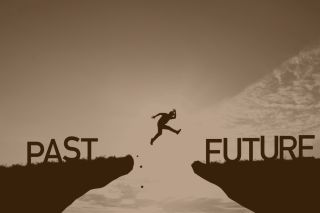Cross-Cultural Psychology
What Can Our Past Really Teach Us About Our Future?
Learn the startling truth about our past and open a doorway to a better tomorrow.
Posted July 26, 2024 Reviewed by Abigail Fagan
Key points
- We’ve been told the best we can do is survive in a consumer culture defined by a loneliness epidemic.
- This is based on two misconceptions about our shared history that limit our beliefs about our future.
- We can remember the belonging we enjoyed and we can reclaim that belonging today.

My mother zipped up my yellow polyester jacket and told me we were headed off to the park. The instant we arrived, I sprinted to the slide and eagerly climbed its stairs. As I neared the top, my mother’s shout startled me. “Be careful or you’ll fall and break your neck!”
This was one of many moments when my mother, always on the lookout for danger, swiftly reeled me in. By the time I was five, I had learned to tuck away my excitement and replace it with caution and vigilance.
What happened to me next? Did my childhood repression of excitement doom me to a future without it? Or did a dormant excitement awaken in adolescence and blossom in adulthood?
Psychologists, philosophers, anthropologists, and archeologists are pondering a very similar question about humanity. They are examining scattered pieces of our prehistory and asking: What can our shared past tell us about our collective future?
We Have It All Wrong
We hold two misconceptions about our early history that limit our beliefs about our future. The first originates with Thomas Hobbes and the second with Jean-Jacques Rousseau.
In the influential 1651 publication, Leviathan, Thomas Hobbes imagines prehistoric humans living in a terrifying world characterized by brutality, anarchy, and the code of “kill or be killed.” Humanity’s rescue only arrives sometime around the 1500s in the form of a government system enforcing inflexible laws and reining in our violent natures. Humanity’s future, per Hobbes, must be either survival under harsh rule or a return to kill-or-be-killed.
In his widely distributed 1754 publication, Discourse on the Origin and the Foundation of Inequality Among Mankind, Jean-Jacques Rousseau imagines an entirely different prehistory where early humans live an idyllic life in tiny tribes. Everything goes well for all of us humans until, ten thousand years ago, agriculture arrives and mucks everything up. Agriculture makes cities possible; more and more people begin living together; and bureaucratic governments form alongside police forces, legal systems, standing armies, and tax collectors. All these large bureaucracies are at the heart of the troubles we experience today, Rousseau explains, and these will continue to haunt us, disrupting our shared future.
But…
It is widely accepted that both Hobbes and Rousseau didn’t know much about anthropology, archeology, or psychology. Both were talking through their proverbial hats.
And…
There are a few things about prehistoric humans and the lives they lived that we can say with certainty. Remarkably, these can guide us toward a better future.
It’s All About Belonging
We know prehistoric humans grew up and lived their lives in small villages. But what were their village lives really like? To answer this question, today’s anthropologists examine the few remaining present-day villages, as well as the available written history of indigenous villages over the past few centuries.
Chaudhary, Salali, and Swanepoel (2024) studied a modern-day tribe of hunter-gatherers living in the Republic of Congo. They tracked how caregivers responded to children and documented three key findings:
- Multiple caregivers responded to crying children by comforting, feeding, holding, and soothing them (but never scolding).
- Children were responded to very quickly, in 25 seconds or less.
- Children received about nine hours of close contact with various caregivers every day (a sharp contrast to infants in our marketplace culture who receive less than 30 minutes daily).
All this made national headlines (e.g. Farrant, 2023) because it tells us children in village cultures receive attentive, attuned care (perhaps more so than children in today’s consumer culture).
But, were villages great places for children and adults alike? That’s what anthropologist David Graeber and archeologist David Wengrow (2021) set out to discover when they asked following question: If you and I had a choice between the village life our ancestors experienced and life in our present-day culture, which would we choose?
They turned to writings from early Colonial times and found the stories of Europeans adopted by indigenous villages and later given a choice of where to live. Other writings told of American Indians adopted into Europe’s culture later given the option to live in either world.
Time and again, these Europeans and American Indians chose life in indigenous villages. The Europeans wrote about the relief they felt from the endless demands of individual work lives, free at last from the exhaustion of it all. But by far the most frequently cited reason was belonging. Europeans and American Indians alike wrote of the social bonds and mutual care they all said were simply impossible to find in the consumer culture.
Of course they made this choice…
“None of us exists except in relationship; we are born in relationship and need relationships to know who we are in this world,” declares psychologist Richard Erskine (2011). “It is the power of being with others that shapes our brains,” explains neuroscientist Louis Cozolino (2006). Humans will always choose a village life of interwoven connection and interdependence over one spent in the isolation of the consumer culture.
Remembering Our Future
So, what does our past really tell us about our future?
The voices of history remind us of the bonding and belonging we once enjoyed living together in small village settings. They tell us we prefer this to the epidemic of loneliness that defines our modern-day culture.
If we listen to these voices from our shared history, we can prepare ourselves to embark on the adventure of a lifetime.
It is time we learn to build small communities of connection and mutuality within our larger marketplace cultures.
(My future columns will explore how we arrive here together.)
References
Chaudhary, N., Salali, G. D., & Swanepoel, A. (2024). Sensitive responsiveness and multiple caregiving networks among Mbendjele BaYaka hunter-gatherers: Potential implications for psychological development and well-being. Developmental Psychology, 60(3), 422–440. https://doi.org/10.1037/dev0001601
Cozolino, L. (2006). The neuroscience of human relationships: Attachment and the developing social brain. W. W. Norton & Company.
Erskine, R. G. (2011, April 21). Attachment, relational-needs, and psychotherapeutic presence [Keynote address]. International Integrative Psychotherapy Association Conference, Vichy, France. Retrieved from https://www.integrativetherapy.com/en/articles.php?id=73
Farrant, T. (2023, November 15). Study reveals Stone Age babies belonging to tribes may have received better parenting. Euronews. https://www.euronews.com/culture/2023/11/15/study-reveals-stone-age-bab…
Geroulanos, S. (2024). The invention of prehistory: Empire, violence, and our obsession with human origins. Liveright Publishing Corporation.
Graerber, D., & Wengrow, D. (2021). The Dawn of Everything: A New History of Humanity. Farrar, Straus and Giroux.
Hobbes, T. (2017). Leviathan (C. Brooke, Ed.). New York: Penguin Classics. (Original work published 1651).
Rousseau, J. (2014). The Major Political Writings of Jean-Jeacques Rousseau: The Two “Discourses” and the Social Contract. (J. Scott, Ed.). University of Chicago Press. (Original work published 1754).




